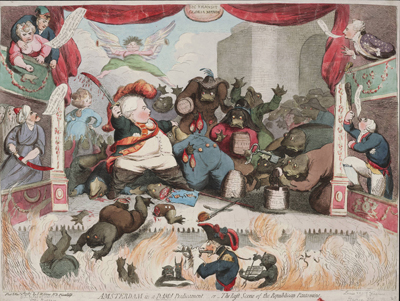Amsterdam in a Damn'd Predicament...
In Holland in 1787 the so-called Patriots or Free Corps, encouraged and partially supported by France, were revolting against the Stadtholder's party or Orangists. As the power of the Patriots increased, Princess Wilhelmina successfully engaged her brother King Frederick William II of Prussia to intervene on behalf of her husband, William V of Orange.
When the Prussian army, led by the Duke of Brunswick-Wolfenbuttel laid siege to Amsterdam, the Patriots expected but did not receive further French support. English naval preparations in support of the Orangists had effectively discouraged the French from proceeding, and the uprising was soon defeated.
In October, 1787 there had been several prints on the subject by Johann Heinrich Ramberg, the Dutch caricaturist, with titles like Rehearsal in Holland (showing pathetic Dutch burghers shooting at a crude chalk drawing of a Prussian soldier) and Performance in Holland (showing the Dutch fleeing from the onlslaught of the real Prussians) but without any theatrical imagery.

or the Last Scene of the Republican Pantomime [1787]
© Lewis Walpole Library, Yale University
With his usual sensitivity to the implicit metaphors of political language and his enduring feeling that politics is after all a performance art, Gillray portrays the siege of Amsterdam as a theatrical pantomime. As Gillray would certainly have known the pantomime was both musical and farcical, deriving from the Italian Commedia dell'Arte with an emphasis on physical, slapstick comedy. He would also have known that it encouraged audience participation.
Both are in full display in this print. At center stage, a bloated and heavily caricatured Prince of Orange hacks away at his foes. The Dutch Patriots are all portrayed as French frogs, some already bloodied and terrified, others in abject submission, proferring the key to the city as well as Holland gin, butter, milk and honey. In the background more frogs fawn upon Wilhelmina, the Princess of Orange while she invites them to kiss her posterior.
In the orchestra pit (of hell), a French military flutist, joined by assorted demons, provides the musical accompaniment to the action. In the boxes at stage right, George III threatens Louis the XVI with an oak club (an allusion perhaps to the practice of throwing clubs at cocks on Shrove Tuesday). For his part, Louis is obviously dismayed.
In the boxes at stage left, tensions between the repressive Sultan of Turkey and famously sexual Catherine the Great of Russia are about to explode into what was to become the second Russo-Turkish war.
As so often happens with Gillray's prints, there are no real heroes on display. The figure of Fame over William has two trumpets blowing in opposite directions. And the theater banner above the scene effectively suggests that this is simply the way of the world.
There is an alternative and historically more accurate version of this print featuring the Prussian Duke of Brunswick in place of William of Orange. For as Gillray's later prints like The Orangerie, or the Dutch Cupid Reposing, after the Fatigues of Planting (1796) and The Man of Feeling, in Search of Indispensibles (1800) suggest, the Prince of Orange obviously preferred to make love not war. Without the Duke of Brunswick's intervention, it is doubtful whether William could have hung on to his kingdom for even as long as he did.

© Trustees of the British Museum
Sources and Reading
- Commentary from the British Museum on Amsterdam in a Damn'd Predicament...
- "William V, Prince of Orange," Wikipedia
- "Charles William Ferdinand, Duke of Brunswick-Wolfenbuttel," Wikipedia
- Thomas Wright and R.H. Evans, Historical and Descriptive Account of the Caricatures of James Gillray, #29
Comments & Corrections
NOTE: Comments and/or corrections are always appreciated. To make that easier, I have included a form below that you can use. I promise never to share any of the info provided without your express permission.